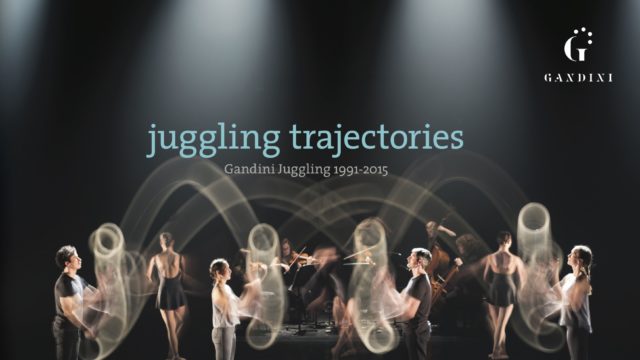Juggling Trajectories is the first book to be published by Gandini Juggling’s imprint, Gandini Press, and is an interesting and rich retrospective of 25 years as a company, packaged as a hefty coffee table showpiece.
More than 400 landscape-format pages focus on the work the company have created over the last quarter century and, in doing so, offer insights into juggling as an art form, which rarely receives critical attention in the broader cultural sphere. As prolific creators, Gandini Juggling’s familiarity with both ‘high art’ and ‘commercial entertainment’ sectors – and ground between the two – has inspired a book that is accessible to juggler fans and strangers to the form alike, and is ideal for browsing, or for taking a pot-luck dip into its pages.
Author Thomas JM Wilson is a performance maker and academic who has followed the company’s work since the 1990s. His observations are combined with interviews, guest essays, diagrams and luscious photography to give a wide perspective that focuses on the creative impulses, intents and processes of the Gandinis. Successes and strengths are illuminated, though failures and challenges are not interrogated.
Designer Marylis Ramos’ strong, contemporary visual concept is, fittingly, key to the book’s unique character. Each spreads remind me of a clean, well laid out webpage, guiding the eye and making me want to keep moving forwards. In addition to a regular contents list, Juggling Trajectories offers an unusual visual map to illustrate the different paths – or patterns – the material follows.
The book is split into seven main chapters, each thematically named for a thread of intent in the company’s work. They’re chronologically ordered, based upon when each feature rose into prominence in the shows, whilst recognising the overlap and simultaneous existence of these concerns throughout the entire 25 year period. Each chapter is then made up of discrete segments that, together, offer a number of viewpoints to allow a bigger picture to form.
The influence of other artists and art forms is acknowledged, from the earliest days of dance experimentation to the more recent explorations of visual art dramaturgies. A significant model in Gandini Juggling’s methodology is that of choreographer Merce Cunningham’s Events, where segments of existing choreographies are re-used and recycled alongside original material to develop a body of work for multiple settings and demands. The material of Juggling Trajectories imitates this process, with frequent repetition of the text across segments that allows each to stand alone. This is not a book designed to be read from cover to cover in one sitting, but to be digested in morsels, like a collection of short stories.
38 Gandini productions are profiled through the course of the book, which by themselves provide an excellent research resource. Added to that are commentaries on the company’s collaborative methods, their experiments with musicality, economic balance as entertainment professionals, and explanations of particular juggling terminologies and tools. The bibliography lists web sources as well as print and, in the collective spirit of the company, weblinks for juggling resources and artists who’ve worked with the Gandinis are also listed. A few of the video sources credited also have urls attached, presumably the rest are from the Gandinis’ personal archive.
The drives that power Gandini Juggling are revealed in Juggling Trajectories, and how they got to where they are today at the top of their game. It’s a beautiful, substantial and engaging book that proudly demands a slot for juggling in the literature of serious entertainment.
Wilson, Thomas JM. Juggling Trajectories: Gandini Juggling 1991-2015. (London: Gandini Press. 2016) ISBN 978-0-9955024-1-3




